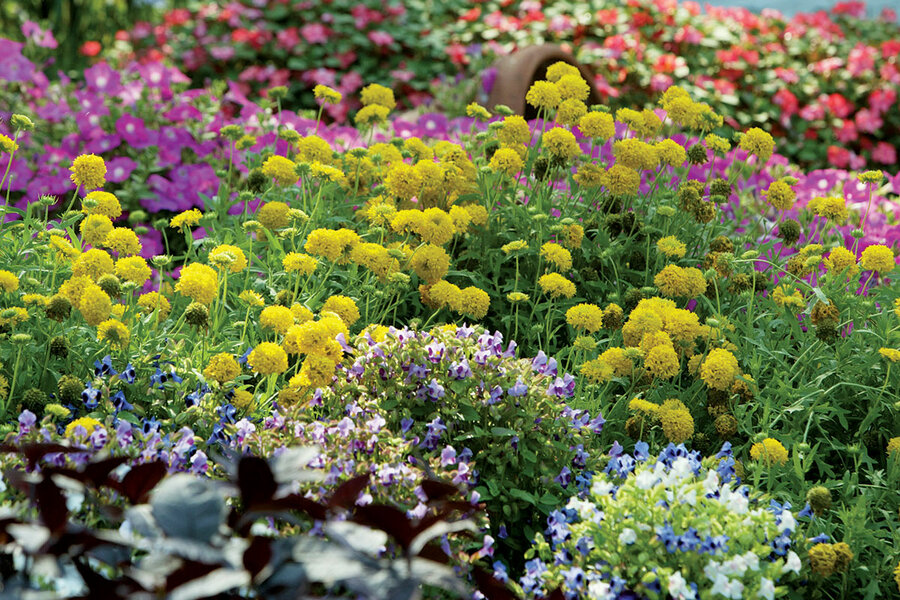The perfect garden? I’ve learned to leave it to nature.
Loading...
In early spring, gardeners stand with their hands on their hips and survey their domains, their eyes loosely focused, and imagine that this is the year everything will be perfect.
Loopy cheer is one of the more charming things about people who garden. They are optimistic beyond all reason; they are willing to indulge in the fantasy that this time, despite decades of evidence to the contrary, everything will flourish and bloom, nary a leaf will be out of place, and weeds will excuse themselves out of sheer embarrassment.
What constitutes perfection, of course, depends on whom you ask. One of my neighbors strives for his version by keeping his yard spanking clean. It is a sterile parkland subdued by chemicals and disciplined by an army of power tools.
Why We Wrote This
A story focused onIn spring, a gardener’s fancy turns to thoughts of creating a perfect garden. And every year, our gardens teach us that we may not be the best judge of what garden perfection is. Ask the birds.
Mine, on the other hand, particularly as it heads into winter, is a rumpled tableau of botanical chaos, all brown sticks and seedpods and buried treasure. A large contingent of birds think it’s just perfect. They won’t even deign to enter my neighbor’s airspace. He doesn’t know what he’s missing. He really doesn’t.
Over here, mere feet away, every dead leaf is in its place: wherever it landed last fall. For a scufflement of juncos and sparrows, my garden is their personal buffet table. There’s a rumbling intelligence below the soil, and it’s clear to me, midwinter, that perfection is a dance that insects and birds and fungi perform together. It’s just a matter of training your eyes to see it.
And yet: By spring, when a young man’s fancy lightly turns to thoughts of love, something similar comes over me; and there I stand, hands on hips, entertaining my own gauzy dream of impeccable flowerbeds dressed in cocoa-brown soil. I will cart my homemade compost around until I run out of it, and then, besotted, I will pay for reinforcements to be dumped in a steaming heap at the curb. Then comes the assault. It’s a clear-and-hold campaign: Sections are finally stripped of dead foliage, unauthorized sprouts are evicted, and mulch is put down and admired. By the time the last bed has been weeded and dressed, the first bed is starting to look like a Chia Pet, and it starts all over again.
For me, the weed-free version of garden perfection lasts for a month or so, then retreats to a sensible compromise reflecting my shaky commitment to the enterprise. By May, my birds have scouted out enough hidden nest sites that I’m leery of disturbing anything. I’ve learned to leave well enough alone. And to know that it is well enough.
There is one area that has looked perfect, by my neighbor’s standards, all winter. This is where, last fall, I smothered a weedy patch with cardboard topped with a massive layer of compost, and I plan to reseed it with a mixture called an “ecolawn.” I can see it already: grass, clover, tiny daisies, yarrow, sweet alyssum, and, ultimately, baby bunnies in flowered frocks and sun hats.
But for the moment it is still urban-perfect, a 6-inch blanket of dark, weed-free soil. The birds are unimpressed. Scrub jays have diligently drilled the area with my proffered peanuts for months, but that’s the extent of it. Jays are said to cache a kabillion nuts, give or take, every winter, and unerringly remember the location of each one. Sure they do!
I would find it daunting to follow a jay around every minute for six months, jotting down nut coordinates and retrieval rates, but maybe someone did. Ornithology is not for the faint of heart.
Why do so many of us strive for order in our gardens? Do our hearts feel too cluttered, our selves too far from perfect? And yet our gardens teach us every year that there’s only so much we can control. Maybe we are not our own best judges. Maybe our birds think we’re perfect – as long as we leave well enough alone.
I’m willing to consider it. So I’m going to fling seeds into my new bed and stand back and watch it turn into a little prairie.
Or possibly a peanut farm. Either way, it’s all good.





